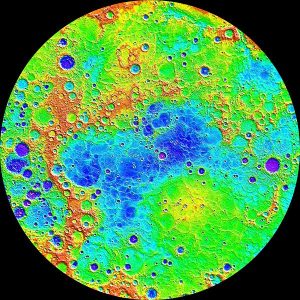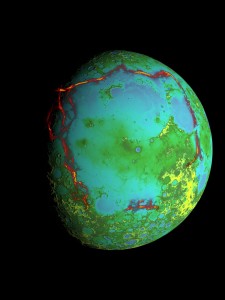 Once a leading theory of the origin of the Earth-Moon system, the Capture Theory is simple and intuitively plausible. The numerous instances of moons with retrograde orbits support it. The lunar orbit’s three moments of inertia are consistent with a past very eccentric orbit, which fit a capture1. However, the Moon would have to come from a different part of the solar system to account for its very depleted iron compared to the Earth’s iron, which means that it would approach the Earth at a high velocity that would prevent capture. Researchers have searched in vain for a braking mechanism that would slow it down so it could be captured. Still, the accumulated evidence and arguments make the Capture Theory a viable one.
Once a leading theory of the origin of the Earth-Moon system, the Capture Theory is simple and intuitively plausible. The numerous instances of moons with retrograde orbits support it. The lunar orbit’s three moments of inertia are consistent with a past very eccentric orbit, which fit a capture1. However, the Moon would have to come from a different part of the solar system to account for its very depleted iron compared to the Earth’s iron, which means that it would approach the Earth at a high velocity that would prevent capture. Researchers have searched in vain for a braking mechanism that would slow it down so it could be captured. Still, the accumulated evidence and arguments make the Capture Theory a viable one.
But around 1980, the Giant Impact Theory came to the fore. It held that Theia, a Mars-sized planet, struck the Earth, with the debris from the collision accreting to constitute the Moon. Giant Impact would account for the nearly identical oxygen isotope ratios of the Earth and Moon. Searches of meteorites found not a single instance of nearly identical ratios. A large majority of scientists came to accept the Giant Impact Theory and reject other theories. However, in recent years new doubts have arisen. For instance, evidence that the impact must have been violent meant that it should have evaporated and dispersed into space any water in Moon rocks; but some of them contain a significant amount.2
A Revised Theory
Meanwhile, one could ask: If the Capture Theory was wrong, why were some of the arguments for it so reasonable? Also, the sole highly persuasive evidence of the Giant Impact Theory was the oxygen isotope ratios. Did Giant Impact belong to the category addressed by the observation of Arthur Conan Doyle: “when a fact appears contrary to a long train of deductions, it invariably proves to be capable of bearing some other interpretation”?
The Capture Theory needed reformulation to make it competitive again. So it was combined with other theorizing in which the Moon and Mercury were originally parts of a combined planet–Merculuna–that was pulled by Jupiter’s gravity from the outer solar system. As Merculuna passed Jupiter, it heated up by tidal friction; and Jupiter’s gravitational pull extracted the Moon from its north polar region (leaving the blue depression in the image). That would account for the excess iron in Mercury and the small amount of iron in the Moon. As a result, the Moon would no longer have to form far from the Earth.
system. As Merculuna passed Jupiter, it heated up by tidal friction; and Jupiter’s gravitational pull extracted the Moon from its north polar region (leaving the blue depression in the image). That would account for the excess iron in Mercury and the small amount of iron in the Moon. As a result, the Moon would no longer have to form far from the Earth.
Sequential Formation
According to the concept of Sequential Formation, the Earth began as part of the planet Terramars in a special niche in the outer solar system. Then, somewhat before 4.5 BYA, Terramars was pulled inward by Jupiter’s gravity, turned molten from tidal heating, and separated into the Earth and Mars, which Jupiter’s gravity tore from the Pacific Basin. Meanwhile, the same materials and processes began to form the planet Merculuna in exactly the same niche. After 3.9 BYA, Merculuna was pulled inward by Jupiter’s gravity along the same trajectory as Terramars. It, too, turned molten from tidal heating and separated into Mercury and the Moon as it passed Jupiter. The smaller mass of Merculuna compared to Terramars, even though the time available for its formation was far longer than that for Terramars, suggests that supplies of the materials to compose it might have come to an end early on. Since the Moon is estimated to have formed around 4.51 BYA,3 Terramars seems to have formed swiftly and was promptly pulled inward from the niche. Merculuna also formed quickly, then lingered there for hundreds of millions of years until it, too, was pulled inward. Therefore, the Earth, Mars, Mercury, and the Moon share very similar oxygen isotope ratios. Rapid formation times for Terramars and Merculuna kept the niche’s conditions stable and thus ensured nearly identical oxygen isotope ratios between the Earth and the Moon.
As the Earth moved past Jupiter into the inner solar system, it was braked by Jupiter’s gravity before escaping. The same braking occurred with the Moon as it followed the Earth’s trajectory 600 million years later. So it ended in a similar orbit and with roughly the same velocity as the Earth, leading to capture. In other words, the origin of the Earth-Moon system was a three-step process: first Sequential Formation, second Separation, and third Capture.
Sequential Formation explains why the oxygen isotope ratios of the Earth and Moon are nearly identical, just as the Giant Impact Theory does. But a Revised Capture Theory decisively outperforms the Giant Impact Theory in terms of matching the special features of the Moon: its heavily cratered surface, the near side/far side dichotomy (including surface features and crustal depths), the complementary low iron of the Moon and high iron of Mercury, the similar very low albedos of Mercury and the Moon, the lunar magnetic field, the remarkable properties of Oceanus Procellarum (the rectangular separation point between Mercury and the Moon  in the image), the water in lunar melt inclusions, the displacement of the center of mass of the Moon, thermal layering, and an orbit–with three moments of inertia–that reveals high past eccentricity. Accreted debris from a Giant Impact fails to explain these features. But they are what we should expect of a Moon extracted from the north polar region of Merculuna. They neatly complement the features of Mercury.
in the image), the water in lunar melt inclusions, the displacement of the center of mass of the Moon, thermal layering, and an orbit–with three moments of inertia–that reveals high past eccentricity. Accreted debris from a Giant Impact fails to explain these features. But they are what we should expect of a Moon extracted from the north polar region of Merculuna. They neatly complement the features of Mercury.
*****
Kenneth J. Dillon is a historical and scientific researcher. See his biosketch at About Us. See also an explanation of the planet Terramars and its fate and the general theory. The origins of the Earth, Mars, Mercury, and the Moon play a role in Dillon’s novel of discovery science Rosemarie.

